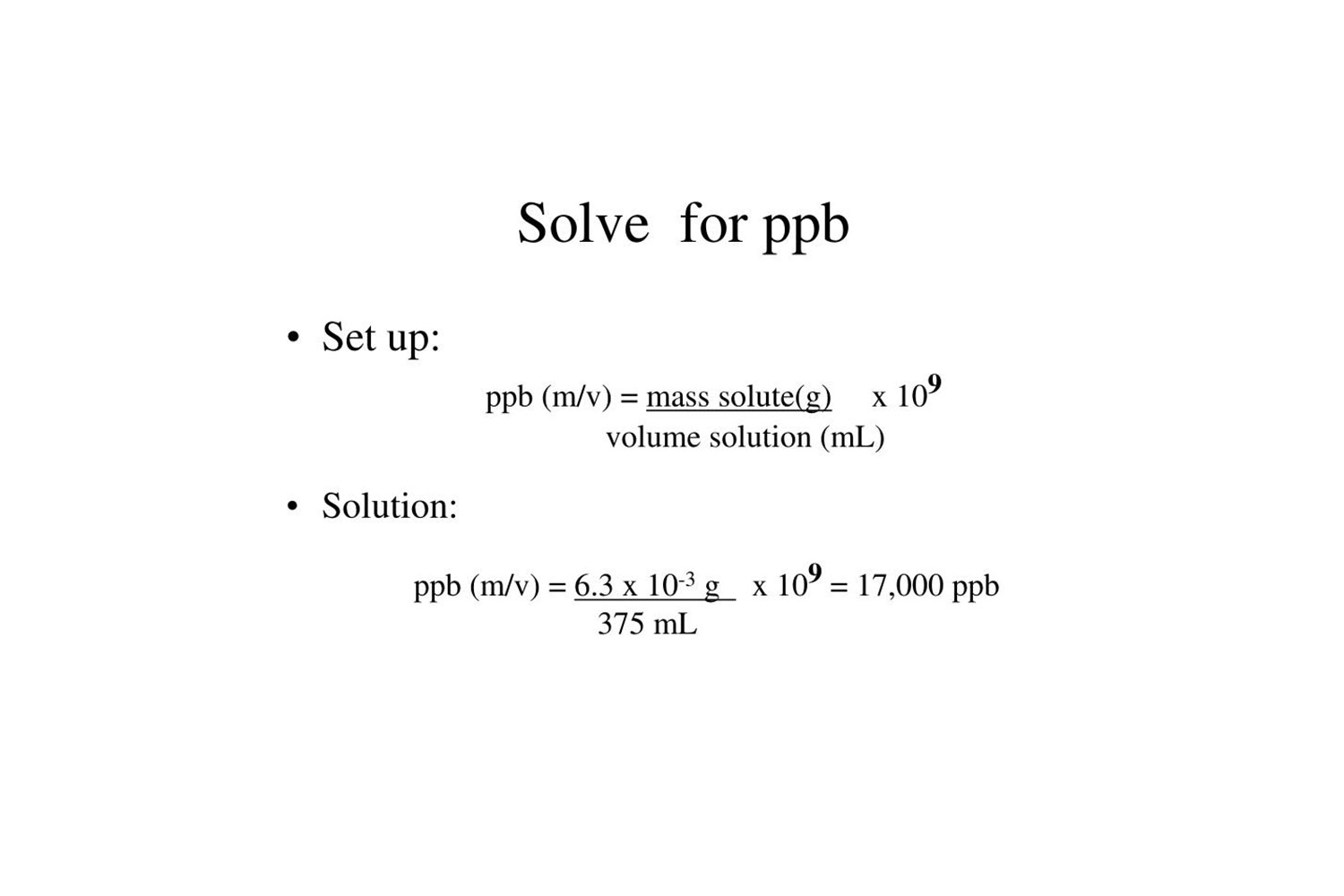
Parts per billion (ppb) is a unit of measurement that is used in various fields, especially in chemistry, to express incredibly small concentrations of substances in a solution. While we are more familiar with percentages, parts per billion takes it to a whole new level, representing one part out of a billion parts in a mixture.
In this article, we will delve into the intriguing world of parts per billion and uncover some extraordinary facts about this minuscule unit of measurement. From its significance in environmental studies to its role in forensic analysis, parts per billion holds great importance in various scientific disciplines. So, sit back and prepare to be amazed by the incredible world of parts per billion.
Key Takeaways:
- Parts per billion (ppb) is a tiny unit of measurement used in chemistry to express extremely small amounts of substances in a mixture, helping scientists make precise calculations and measurements.
- PPB is crucial in environmental studies, pharmaceuticals, and industrial processes, allowing for the detection of pollutants, ensuring medication safety, and maintaining product integrity.
What exactly is a part per billion?
Parts per billion (ppb) is a unit of measurement used to express extremely small concentrations or quantities in a mixture. It represents one billionth of the total units.
Importance of parts per billion in the field of chemistry
Parts per billion is especially important in the field of chemistry, as it helps scientists to determine and express minuscule amounts of substances in a solution. It allows for precise measurements and calculations in various chemical reactions and analytical tests.
Parts per billion in environmental studies
In environmental studies, parts per billion is used to measure the concentration of pollutants in air, water, soil, and food. It allows scientists to assess the impact of contaminants on ecosystems and human health.
The significance of parts per billion in pharmaceuticals
In the pharmaceutical industry, parts per billion is crucial for ensuring the safety and effectiveness of medications. It helps in determining the proper dosage, detecting impurities, and monitoring the quality of drug formulations.
Parts per billion and industrial processes
Industrial processes commonly rely on parts per billion measurements to monitor and control the levels of various chemicals and contaminants. This ensures the compliance with safety regulations and maintains product integrity.
Limitations of parts per billion measurements
While parts per billion is a highly sensitive unit of measurement, it does have certain limitations. For instance, it may not be suitable for substances with extremely high concentrations or substances that are not uniformly distributed in the mixture.
Notable examples of parts per billion
Parts per billion can be seen in real-life examples, such as detecting trace amounts of heavy metals in drinking water, measuring air pollution levels, or determining the concentration of essential nutrients in food and supplements.
The role of parts per billion in scientific research
Parts per billion plays a vital role in scientific research, enabling precise measurements and analysis in various fields like environmental science, toxicology, pharmacology, and nanotechnology.
In conclusion, parts per billion (ppb) is an essential unit of measurement in the world of chemistry. It allows for precise quantification of minuscule amounts of substances and plays a crucial role in various scientific disciplines. Understanding the concept and significance of parts per billion helps scientists, researchers, and industries ensure accuracy and safety in their work.
Conclusion
In conclusion, parts per billion (ppb) is a fascinating unit of measurement that allows us to better understand the concentration of substances in various contexts. From detecting pollutants in the environment to measuring trace amounts of chemicals in food and substances, ppb plays a crucial role in our understanding of chemistry. With its incredible sensitivity and precision, ppb provides insights into the tiniest amounts of substances that can have significant impacts on human health and the environment. By delving into the eight extraordinary facts about ppb, we have gained a deeper appreciation for this unit of measurement and its implications in the field of chemistry.
FAQs
1. What does parts per billion (ppb) mean?
Parts per billion (ppb) is a unit of measurement that represents the ratio of the number of particles or molecules of a substance compared to one billion (10^9) parts of a whole.
2. How is ppb different from other concentration units?
Ppb is extremely sensitive, measuring even the tiniest amounts of substances in a sample. It is more specific than percentage or parts per million (ppm), making it useful for analyzing trace amounts of chemicals and detecting pollutants.
3. What are some applications of ppb?
Ppb is used in various fields, including environmental monitoring, food safety testing, pharmaceutical research, and industrial quality control. It helps identify and measure contaminants, assess product purity, and ensure compliance with regulations.
4. How is ppb measured?
Ppb is typically measured using specialized laboratory equipment, such as spectrometers or gas chromatographs, which can detect and quantify substances to very low concentrations. These instruments provide accurate and reliable results.
5. How does ppb relate to human health?
Ppb is essential for assessing potential risks associated with exposure to harmful substances. By measuring trace amounts of pollutants or toxins in the environment or consumer products, scientists can determine their impact on human health and make informed decisions to mitigate risks.
6. Can ppb be converted to other concentration units?
Yes, ppb can be converted to other concentration units such as parts per million (ppm) or percentage. Conversion factors are used to calculate the equivalent values.
7. Is ppb only used in chemistry?
No, ppb is utilized in various scientific disciplines, including chemistry, toxicology, environmental science, and pharmacology. It is a versatile unit of measurement that aids in understanding the behavior and concentration of substances.
8. Are there any regulations regarding ppb?
Yes, regulatory bodies around the world establish standards and regulations for acceptable levels of certain substances measured in ppb. These guidelines aim to protect public health, the environment, and ensure product safety.
Was this page helpful?
Our commitment to delivering trustworthy and engaging content is at the heart of what we do. Each fact on our site is contributed by real users like you, bringing a wealth of diverse insights and information. To ensure the highest standards of accuracy and reliability, our dedicated editors meticulously review each submission. This process guarantees that the facts we share are not only fascinating but also credible. Trust in our commitment to quality and authenticity as you explore and learn with us.


